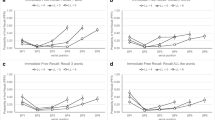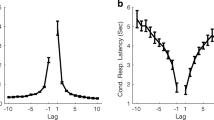Abstract
I reanalyze the free recall data of Murdock, J Exp Psychol 64(5):482–488 (1962) and Murdock and Okada, J Verbal Learn and Verbal Behav 86:263–267 (1970) which show the famous bowing effect in which initial and recent items are recalled better than intermediate items (primacy and recency effects). Recent item recall probabilities follow a logarithmic decay with time of recall consistent with the tagging/retagging theory. The slope of the decay increases with increasing presentation rate. The initial items, with an effectively low presentation rate, decay with the slowest logarithmic slope, explaining the primacy effect. The finding that presentation rate limits the duration of short term memory suggests a basis for memory loss in busy adults, for the importance of slow music practice, for long term memory deficiencies for people with attention deficits who may be artificially increasing the presentation rates of their surroundings. A well-defined, quantitative measure of the primacy effect is introduced.







Similar content being viewed by others
References
Anderson JR (1981) Interference: the relationship between response latency and response accuracy. J Exp Psychol Hum Learn 7:326–343
Barrouillet P, Camos V (2009) Interference: unique source of forgetting in working memory? Trends Cogn Sci 13(4):145–146
Barrouillet P et al (2004) Time constraints and resource-sharing in adults’ working memory spans. J Exp Psychol Gen 133:83–100
Berman MG, Jonides J, Lewis RL (2009) In search of decay in verbal short-term memory. J Exp Psychol Learn Mem Cogn 35(2):317–333
Brown GDA, Chater N, Neath I (2008) Serial and free recall: common effects and common mechanisms? a reply to Murdock (2008). Psychol Rev 115(3):781–785
Castellanos FX, Tannock R (2002) Neuroscience of attention-deficit/hyperactivity disorder: the search for endophenotypes. Nat Rev Neurosci 3:617–628
Dobrunz LE (2002) Release probability is regulated by the size of the readily releasable vesicle pool at excitatory synapses in hippocampus. Int J Dev Neurosci 20:225–236
Farrell S, Lewandowsky S (2004) Modelling transposition latencies: constraints for theories of serial order memory. J Mem Lang 51:115–135
Hofer AM, Lefkimmiatis K (2007) Extracellular calcium and cAMP: second messangers as “Third Messangers”. Physiology 22:320–327
Kandel ER (2001) The molecular biology of memory storage: a dialogue between genes and synapses. Science 294:1030–1038
Lewandowsky S, Farrell S (2008) Short-term memory: new data and a model psychology of learning and motivation. Adv Res Theory 49(49):1–48
Lewandowsky S, Oberauer K, Brown GDA (2008) No temporal decay in verbal short-term memory. Trends Cogn Sci 13(3):120–126
Lewandowsky S, Oberauer K, Brown G (2009) No temporal decay in verbal short-term memory. Trends Cogn Sci 13(3):120–126
Murdock B (1962) The serial position effect of free recall. J Exp Psychol 64(5):482–488
Murdock BB, Okada R (1970) Interresponse times in single-trial free recall. J Verbal Learn and Verbal Behav 86:263–267
Oberauer K, Lewandowsky S (2008) Forgetting in immediate serial recall: decay, temporal distinctiveness, or interference? Psychol Rev 115(3):544–576
Peterson LR, Peterson MJ (1959) Short-term retention of individual verbal items. J Exp Psychol 58:193–198
Reder LM, Park H, Kieffaber PD (2009) Memory systems do not divide on consciousness: reinterpreting memory in terms of activation and binding. Psychol Bull 135(1):23–49
Regehr WG, Delaney KR, Tank DW (1994) The role of presynaptic calcium in short-term enhancement at the hippocampal mossy fiber synapse. J Neurosci 14:523–537
Roman SA, Sosa JA, Mayes L, Desmond E, Boudourakis L, Lin R, Snyder PJ, Holt E, Udelsman R (2005) Parathyroidectomy improves neurocognitive deficits in patients with primary hyperparathyroidism. Surgery 183(6):1121–1129
Rubin DC, Hinton S, Wenzel A (1999) The precise time course of retention. J Exp Psychol Learn Mem Cogn 25:1161–1176
Sankaranarayanan S, Ryan TA (2001) Calcium accelerates endocytosis of vSNAREs at hippocampal synapses. Nat Neurosci 4(2):129–136
Scott R, Rusakov DA (2006) Main determinants of presynaptic Ca2# dynamics at individual mossy fiber–CA3 pyramidal cell synapses. J Neurosci 26(26):7071–7081
Tarnow E (2008) Response probability and response time: a straight line, the tagging/retagging interpretation of short term memory, an operational definition of meaningfulness and short term memory time decay and search time. Cogn Neurodyn 2(4):347–353
Tarnow E (2009) Short term memory may be the depletion of the readily releasable pool of presynaptic neurotransmitter vesicles of a metastable long term memory trace pattern. Cogn Neurodyn 3(3):263–269
Tarnow E (2010a) Atkinson and Shiffrin revisited (submitted)
Tarnow E (2010b) The dynamics of the free recall search (to be submitted)
Verkhratsky A (2005) Physiology and pathophysiology of the calcium store in the endoplasmic reticulum of neurons. Physiol Rev 85:201–279
Wu LG, Ryan TA, Lagnado L (2007) Modes of vesicle retrieval at ribbon synapses, calyx-type synapses, and small central synapses. J Neurosci 27:11793–11802
Wu XS, McNeil BD, Xu J, Fan J, Xue L, Melicoff E, Adachi R, Bai L, Wu LG (2009) Ca(2+) and calmodulin initiate all forms of endocytosis during depolarization at a nerve terminal. Nat Neurosci 12:1003–1010
Yao Chi-Kuang, Lin Yong Qi, Ly Cindy V, Ohyama Tomoko, Haueter Claire M, Moiseenkova-Bell Vera Y, Wensel Theodore G, Bellen Hugo J (2009) A synaptic vesicle-associated Ca2+ channel promotes endocytosis and couples exocytosis to endocytosis. Cell 138(5):947–960
Author information
Authors and Affiliations
Corresponding author
Rights and permissions
About this article
Cite this article
Tarnow, E. Short term memory bowing effect is consistent with presentation rate dependent decay. Cogn Neurodyn 4, 367–376 (2010). https://doi.org/10.1007/s11571-010-9131-z
Received:
Revised:
Accepted:
Published:
Issue Date:
DOI: https://doi.org/10.1007/s11571-010-9131-z




